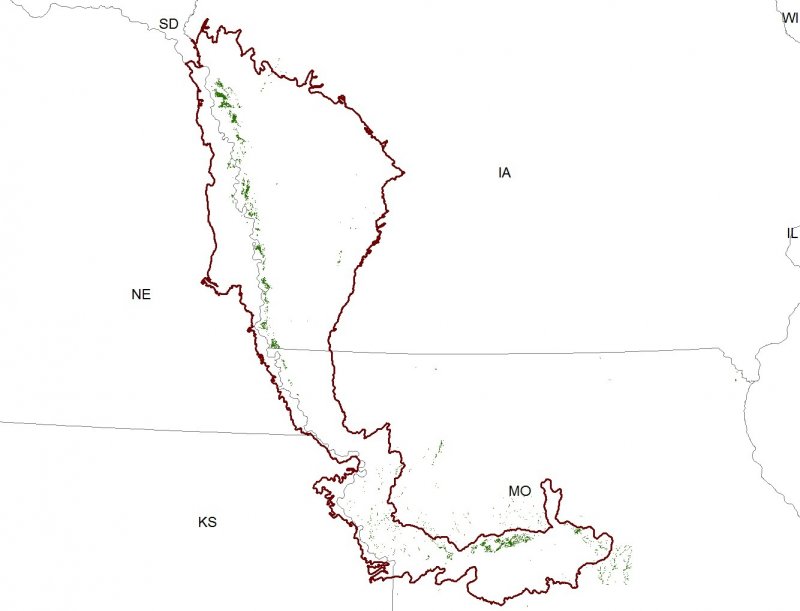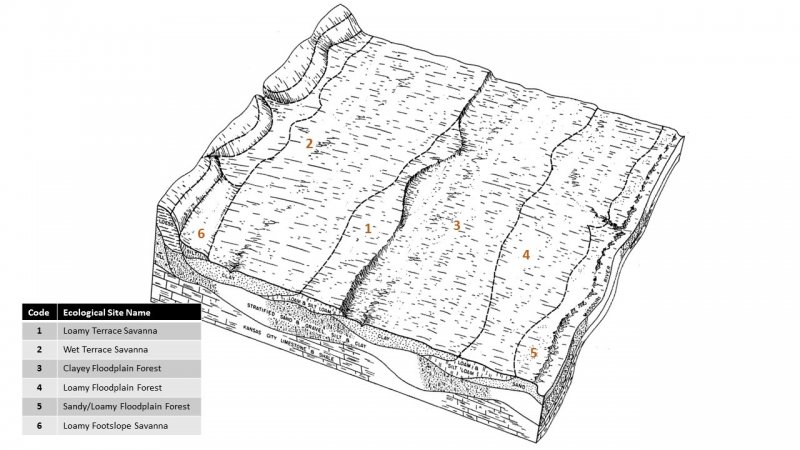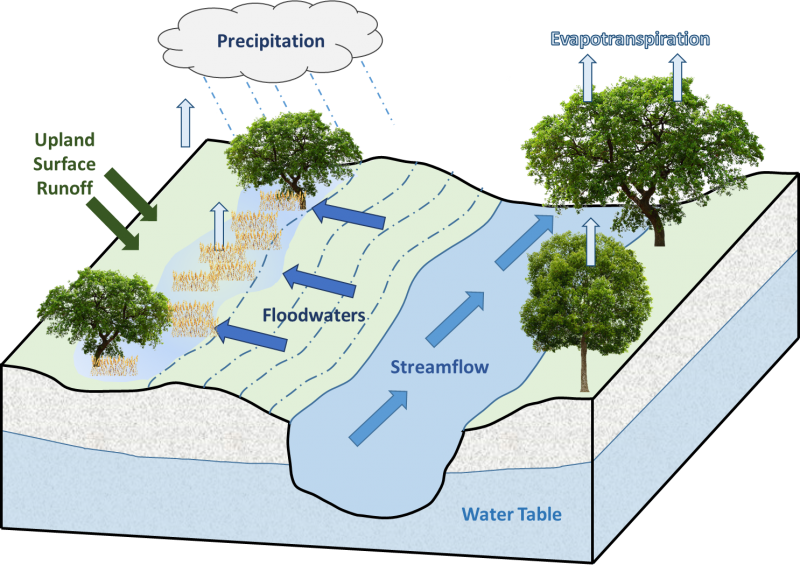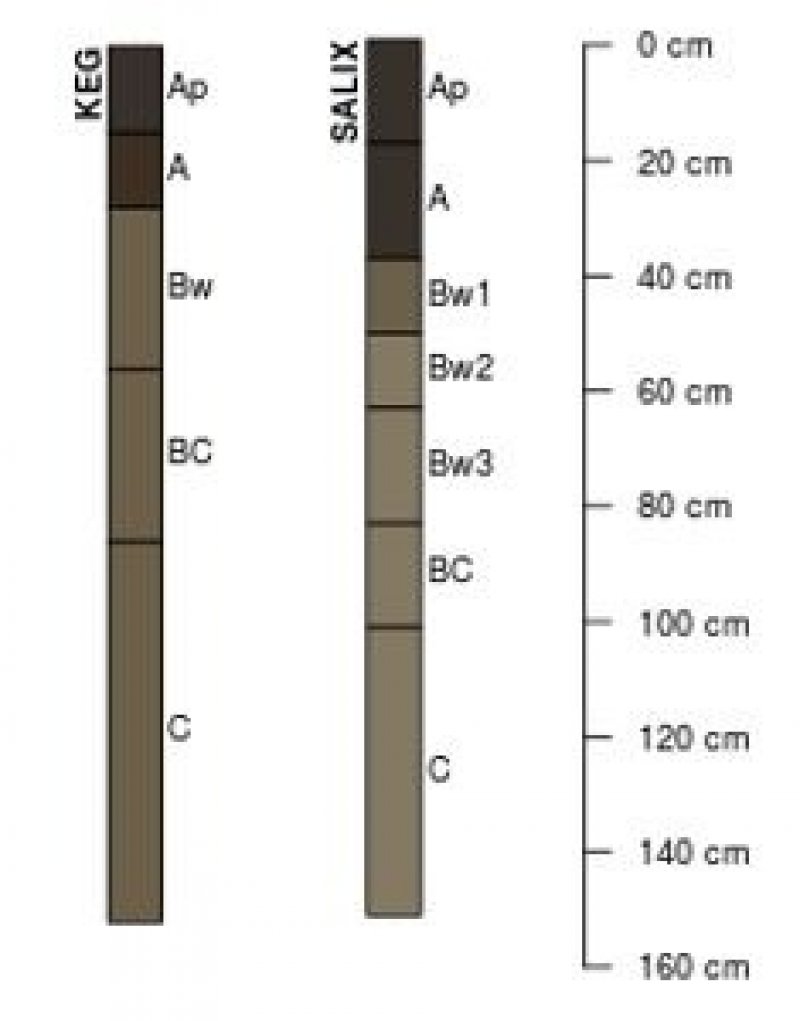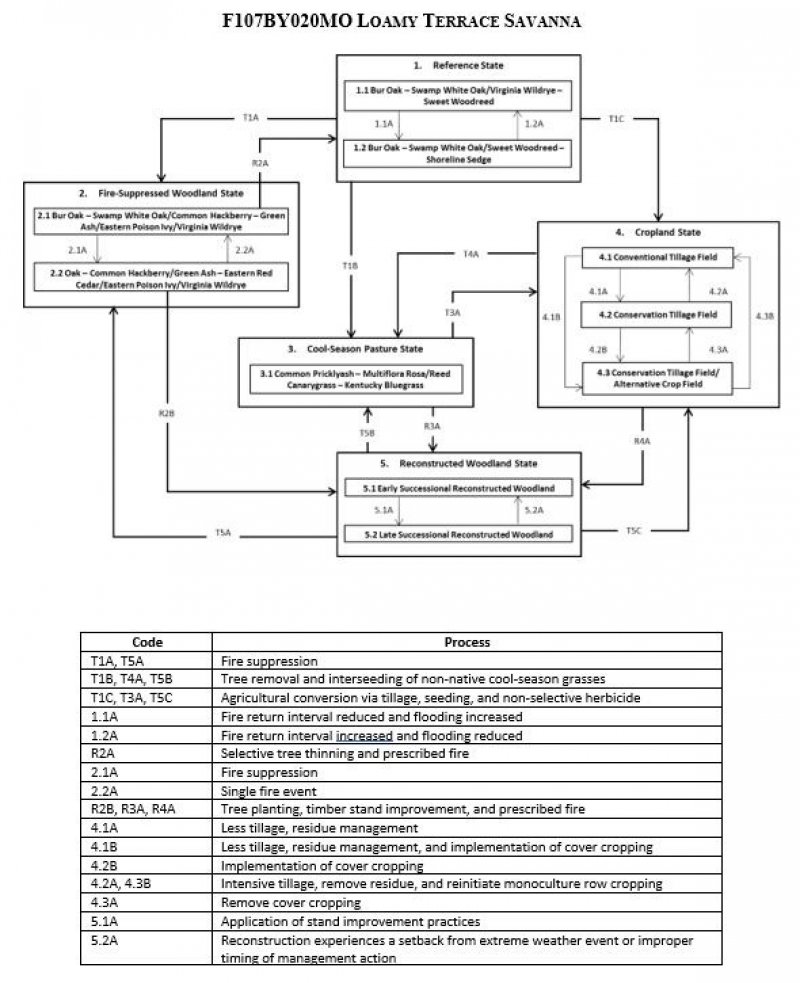
Natural Resources
Conservation Service
Ecological site R107XB020MO
Loamy Terrace Savanna
Last updated: 5/21/2020
Accessed: 11/23/2024
General information
Provisional. A provisional ecological site description has undergone quality control and quality assurance review. It contains a working state and transition model and enough information to identify the ecological site.
Figure 1. Mapped extent
Areas shown in blue indicate the maximum mapped extent of this ecological site. Other ecological sites likely occur within the highlighted areas. It is also possible for this ecological site to occur outside of highlighted areas if detailed soil survey has not been completed or recently updated.
MLRA notes
Major Land Resource Area (MLRA): 107X–Iowa and Missouri Deep Loess Hills
The Iowa and Missouri Deep Loess Hills (MLRA 107B) includes the Missouri Alluvial Plain, Loess Hills, Southern Iowa Drift Plain, and Central Dissected Till Plain landform regions (Prior 1991; Nigh and Schroeder 2002). It spans four states (Iowa, 53 percent; Missouri, 32 percent; Nebraska, 12 percent; and Kansas 3 percent), encompassing over 14,000 square miles (Figure 1). The elevation ranges from approximately 1,565 feet above sea level (ASL) on the highest ridges to about 600 feet ASL along the Missouri River near Glasgow in central Missouri. Local relief varies from 10 to 20 feet in the major river floodplains, to 50 to 100 feet in the dissected uplands, and loess bluffs of 200 to 300 feet along the Missouri River. Loess deposits cover most of the area, with deposits reaching a thickness of 65 to 200 feet in the Loess Hills and grading to about 20 feet in the eastern extent of the region. Pre-Illinoian till, deposited more than 500,000 years ago, lies beneath the loess and has experienced extensive erosion and dissection. Pennsylvanian and Cretaceous bedrock, comprised of shale, mudstones, and sandstones, lie beneath the glacial material (USDA-NRCS 2006).
The vegetation in the MLRA has undergone drastic changes over time. Spruce forests dominated the landscape 30,000 to 21,500 years ago. As the last glacial maximum peaked 21,500 to 16,000 years ago, they were replaced with open tundras and parklands. The end of the Pleistocene Epoch saw a warming climate that initially prompted the return of spruce forests, but as the warming continued, spruce trees were replaced by deciduous trees (Baker et al. 1990). Not until approximately 9,000 years ago did the vegetation transition to prairies as climatic conditions continued to warm and subsequently dry. Between 4,000 and 3,000 years ago, oak savannas began intermingling within the prairie landscape, while the more wooded and forested areas maintained a foothold in sheltered areas. This prairie-forest transition ecosystem formed the dominant landscapes until the arrival of European settlers (Baker et al. 1992).
Classification relationships
Major Land Resource Area (MLRA): Iowa and Missouri Deep Loess Hills (107B)
USFS Subregions: Central Dissected Till Plains Section (251C); Missouri River Alluvial Plain (251Cg) (Cleland et al. 2007)
U.S. EPA Level IV Ecoregion: Missouri Alluvial Plain (47d)
Biophysical Setting (LANDFIRE 2009): Eastern Great Plains Floodplain System (4214690)
Ecological Systems (National Vegetation Classification System, Nature Serve 2015): North-Central Interior Floodplain (CES202.694)
Eilers and Roosa (1994): Missouri River Alluvium Region: Riverine Systems
Iowa Department of Natural Resources (INAI n.d.): Bur Oak – Swamp White Oak Floodplain Forest
Missouri Natural Heritage Program (Nelson 2010): Mesic Bottomland Woodland
Plant Associations (National Vegetation Classification System, Nature Serve 2015): Quercus macrocarpa – Quercus bicolor – Carya laciniosa/Leersia spp. – Cinna spp. Floodplain Forest (CEGL002098)
Ecological site concept
Loamy Terrace Savannas are located within the green areas on the map (Figure 1). They occur on elevated terraces in floodplains. Soils are Mollisols that are moderately well to well-drained and very deep, formed from alluvium. The site experiences rare, shallow flooding, resulting in a plant community comprised of both upland and hydrophytic woody and herbaceous vegetation (Nelson 2010). These sites occur adjacent to Wet Terrace Savannas and higher than floodplain forest ecological sites.
The historic pre-European settlement vegetation on this site consisted of a canopy of trees and a dense understory of grasses, sedges, and forbs. Bur oak (Quercus macrocarpa Michx.) and swamp white oak (Quercus bicolor Willd.) are the dominant trees in this ecological site, while Virginia wildrye (Elymus virginicus L.) and sweet woodreed (Cinna arundinacea L.) are the dominant and characteristic species of the ground layer (Nelson 2010; NatureServe 2015). Herbaceous species typical of an undisturbed plant community associated with this ecological site include bearded shorthusk (Brachyelytrum erectum (Schreb. Ex Spreng.) P. Beauv.) and eastern purple coneflower (Echinacea purpurea (L.) Moench) (Drobney et al. 2001; Nelson 2010; Ladd and Thomas 2015). Historically, flooding and fire were the primary disturbance factors of this ecological site (LANDFIRE 2009; Nelson 2010).
Associated sites
| F107XB017MO |
Clayey Floodplain Forest Clayey alluvium soils on floodplains adjacent to stream channel including Albaton, Blencoe, Blend, Leta, Myrick, Onawet, Owego, Parkville, Percival, and SansDessein |
|---|---|
| R107XB021MO |
Wet Terrace Savanna Alluvial soils that are somewhat poorly to poorly-drained including Blackoar, Blencoe, Bremer, Burcham, Hornick, Luton, and Nevin |
Similar sites
| R107XB008MO |
Loamy Footslope Savanna Loamy Footslope Savannas occur high on a higher landscape position and soils are formed from colluvium |
|---|---|
| R107XB021MO |
Wet Terrace Savanna Wet Terrace Savannas occur in a similar landscape position but soils are moister and herbaceous vegetation is a more mesic composition |
Table 1. Dominant plant species
| Tree |
(1) Quercus macrocarpa |
|---|---|
| Shrub |
Not specified |
| Herbaceous |
(1) Elymus virginicus |
Click on box and path labels to scroll to the respective text.
